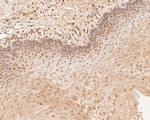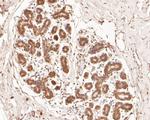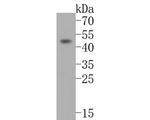Search Thermo Fisher Scientific
图: 1 / 5
PHLDA1 Antibody (PA5-119776) in IHC (P)





产品信息
PA5-119776
种属反应
宿主/亚型
分类
类型
抗原
偶联物
形式
浓度
纯化类型
保存液
内含物
保存条件
运输条件
RRID
产品详细信息
Positive Control: Mouse brain tissue lysates, human lung carcinoma tissue, human breast tissue, human esophagus tissue, mouse brain tissue.
Subcellular Location: Nucleolus. Cytoplasm. Cytoplasmic vesicle
靶标信息
Cytotoxic T lymphocyte (CTL)-mediated cytotoxicity constitutes an important component of specific effector mechanisms in immunosurveillance against virus-infected or -transformed cells. Two mechanisms appear to account for this activity, one of which is the perforin-based process. Independently, a FAS-based mechanism involves the transducing molecule FAS (APO-1) and its ligand (FAS-L). The human FAS (APO-1) protein is a 48 kDa cell surface glycoprotein that belongs to a family of receptors that includes CD40, nerve growth factor receptors and tumor necrosis factor receptors. The FAS antigen is expressed on a broad range of lymphoid cell lines, and is expressed at high levels in T cells subsequent to crosslinking of the T cell receptor (TCR). A previously undescribed protein, TDAG51, restores activation- induced apoptosis in cells that have lost the ability to display Fas in response to activation.
仅用于科研。不用于诊断过程。未经明确授权不得转售。
篇参考文献 (0)
生物信息学
蛋白别名: Apoptosis-associated nuclear protein; Pleckstrin homology-like domain family A member 1; pleckstrin homology-like domain, family A, member 1; PQ-rich protein; PQR protein; Proline- and glutamine-rich protein; Proline- and histidine-rich protein; proline-histidine rich protein; T-cell death associated; T-cell death-associated gene 51 protein
基因别名: DT1P1B11; PHLDA1; PHRIP; Tdag; TDAG51
UniProt ID: (Human) Q8WV24, (Mouse) Q62392
Entrez Gene ID: (Human) 22822, (Mouse) 21664



